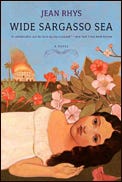Wide Sargasso Sea takes a character from Charlotte Brontë's classic novel Jane Eyre - the first wife Mr. Rochester's father pressured him into marrying - and imagines her life in Jamaica. In 1833, slavery was abolished in Britain and its Caribbean territories. Not long after, Antoinette Cosway grows up as a white Creole whose wealthy family, with the loss of its slaves, has lost its position in society. Black Jamaicans taunt her as a "white cockroach." She is both resented and cared for by a handful of black Jamaicans who stay on with her widowed mother, a beautiful, thoughtless and mentally frail woman who marries again to a man who sends Antoinette away to be raised in a convent.
Wide Sargasso Sea is intensely atmospheric, almost Gothic in its sense of impending catastrophe, but Antoinette is not so much trapped in a house full of dark secrets as on an island full of dark secrets whose overgrown tropical splendor feels lushly oppressive. Like Jane in Jane Eyre, Antoinette is a victimized child. Unlike Jane, she does not have the intelligence or strength of will as an adult to escape further victimization. The two novels diverge so widely in setting, style and theme that, although it's interesting to compare them, Wide Sargasso Sea stands alone and does not in the least require readers to have read Jane Eyre in order to follow the story. In fact, readers charmed by Jane Eyre may find less to charm them in the sparer, more impressionistic style of Wide Sargasso Sea and the bleak incapacity of its central character. In Jane Eyre, Mr. Rochester’s character flaws are evident, but here he has few compensating virtues. Wide Sargasso Sea is a novel to be appreciated in its own right. Readers looking for a rich historical atmosphere will find it a masterful portrayal of a tropical island in which the power structure has been suddenly upended, leaving simmering conflict in its wake. (1966; most editions between 150 and 175 pages)




